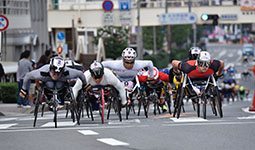Home > Highlighting JAPAN > Highlighting Japan June 2018 > Regional Revitalization through Sports
Highlighting JAPAN


World’s First Wheelchair International Marathon
Almost two hundred and fifty athletes from fifteen countries including Japan will roll at high speed during the 38th Oita International Wheelchair Marathon—the biggest event of its kind in the world—assisted by roughly two thousand volunteers.
At the Rio Paralympics two years ago, people got the chance to observe not just the athletes in action but also how their racing equipment has evolved. Wheelchairs for daily use and those for racing are radically different, with the racing versions measuring 180 centimeters in length and having three tires as narrow as competitive cycling tires. As of 31 January 2018, the top times recorded at the Oita International Wheelchair Marathon for the full marathon are 1 hour, 20 minutes, 14 seconds for men and 1 hour, 38 minutes, 7 seconds for women.
Oita staged the world’s first wheelchair-only marathon in 1981 to commemorate the International Year of Disabled Persons. The organizer was the late Dr. Yutaka Nakamura, the director of Oita Nakamura Hospital, known as the father of the Japanese Paralympics. After studying at the Stoke Mandeville Hospital’s National Spinal Injuries Centre in the United Kingdom, Nakamura began to incorporate sports into rehabilitation to strengthen disabled patients’ bodies and help mend their mental state. He called for sports competitions for disabled people in Oita long before the rest of the country did, and advocated for the Tokyo Paralympics as well.
While about fifty people participate in the wheelchair marathon at the Paralympics, between two hundred to two hundred and fifty athletes that include invited racers from inside Japan and out—and representing fifteen countries—gather at the Oita marathon. Athletes with serious upper-body disabilities such as paralyzed torsos and elbows that cannot bend are also allowed to participate, contributing to the surge in numbers.
Two thousand volunteers support these athletes, led by the local interpreters’ organization, Can-do, which provides an active base throughout the competition. The organization assists with wheelchair repairs, transports the athletes, and accompanies them to the doctor and on errands during the competition. Many others—such as local high school students and employees of sponsored companies who have undergone training—also assist. Most volunteers do the same type of job every year as they have gained expertise at both the work and assisting the athletes, and look forward to volunteering.
The residents of Oita also pick up roadside trash, cheer for the athletes, and welcome them warmly in all kinds of ways. If they find cracks in the road used for the racecourse, residents will even contact the city and prefecture because they know the wheelchair tires used on the racers puncture easily.
This race is considered a gateway to success. The oldest competitor is 92 years old, and will be participating for the 37th time this year alongside three other senior athletes who have also raced every year. The event has raised a great deal of interest, to the point of being broadcast across all of Oita Prefecture since the year before last, as well as being featured on a Japan-wide BS channel. There are plans for TV drama depicting Dr. Nakamura’s efforts to be broadcast this summer.
The maximum speed of these racing wheelchairs is 40 kilometers per hour, with the top athlete speeding through the 42.195-kilometer course in 1 hour and 20 minutes. The moment when the competitors sprint from the starting line on November 18 of this year will be one of unmatched intensity. Scenes of athletes struggling uphill as spectators cheer encouragingly until the athletes rally and go on will be equally uplifting.
Local people consider the race “Oita’s treasure.” In 2020, they will celebrate the event’s fortieth anniversary. In this place that pioneered sports for disabled athletes in Japan, the history, pride and hospitality of the people will live on.
© 2009 Cabinet Office, Government of Japan







